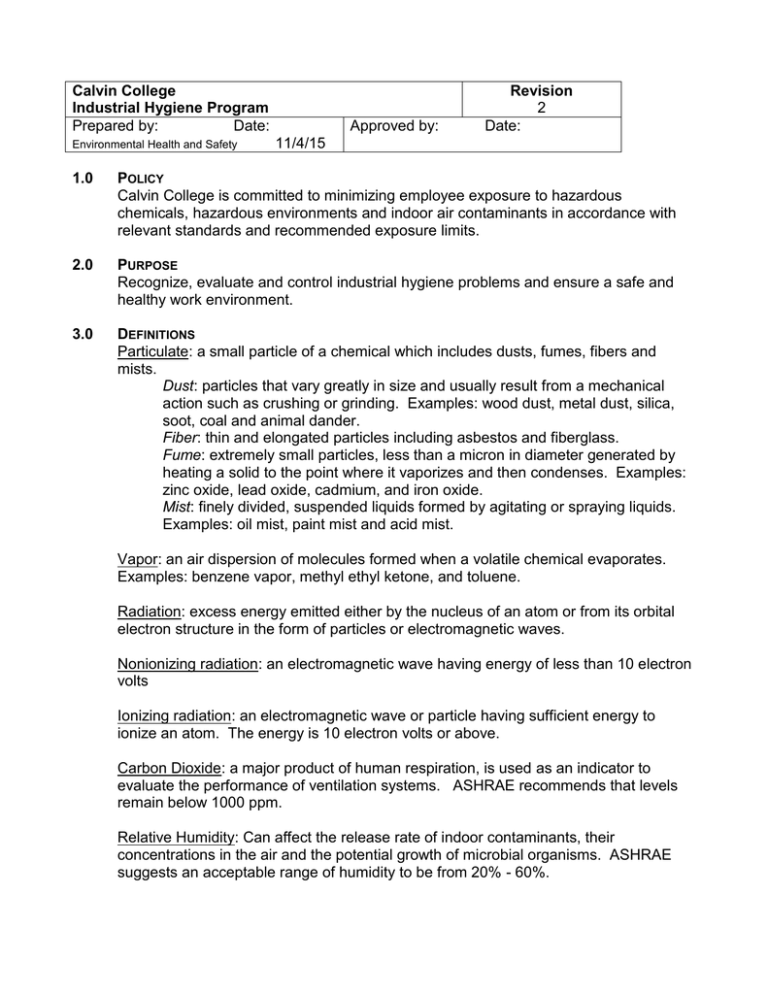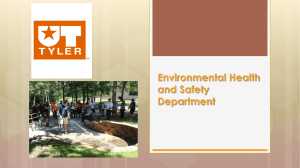Calvin College Revision Industrial Hygiene Program 1.0
advertisement

Calvin College Industrial Hygiene Program Prepared by: Date: Environmental Health and Safety Approved by: Revision 2 Date: 11/4/15 1.0 POLICY Calvin College is committed to minimizing employee exposure to hazardous chemicals, hazardous environments and indoor air contaminants in accordance with relevant standards and recommended exposure limits. 2.0 PURPOSE Recognize, evaluate and control industrial hygiene problems and ensure a safe and healthy work environment. 3.0 DEFINITIONS Particulate: a small particle of a chemical which includes dusts, fumes, fibers and mists. Dust: particles that vary greatly in size and usually result from a mechanical action such as crushing or grinding. Examples: wood dust, metal dust, silica, soot, coal and animal dander. Fiber: thin and elongated particles including asbestos and fiberglass. Fume: extremely small particles, less than a micron in diameter generated by heating a solid to the point where it vaporizes and then condenses. Examples: zinc oxide, lead oxide, cadmium, and iron oxide. Mist: finely divided, suspended liquids formed by agitating or spraying liquids. Examples: oil mist, paint mist and acid mist. Vapor: an air dispersion of molecules formed when a volatile chemical evaporates. Examples: benzene vapor, methyl ethyl ketone, and toluene. Radiation: excess energy emitted either by the nucleus of an atom or from its orbital electron structure in the form of particles or electromagnetic waves. Nonionizing radiation: an electromagnetic wave having energy of less than 10 electron volts Ionizing radiation: an electromagnetic wave or particle having sufficient energy to ionize an atom. The energy is 10 electron volts or above. Carbon Dioxide: a major product of human respiration, is used as an indicator to evaluate the performance of ventilation systems. ASHRAE recommends that levels remain below 1000 ppm. Relative Humidity: Can affect the release rate of indoor contaminants, their concentrations in the air and the potential growth of microbial organisms. ASHRAE suggests an acceptable range of humidity to be from 20% - 60%. Mold: A very large group of microscopic fungi that live on plant or animal matter and can be air-, water-, or insect-borne. 4.0 RESPONSIBILITIES ENVIRONMENTAL HEALTH & SAFETY Investigate complaints Conduct interviews with building occupants Walk through the affected area Determine employee’s exposure to any substance regulated by a standard which requires monitoring. For those hazardous chemicals and/or substances where no relevant standard exists or recommended limit has been established, the exposure shall be evaluated and limited to the lowest reasonably achievable limit Monitor for contaminants when deemed necessary Recommend corrective action and control measures Coordinate corrective actions with appropriate representatives Halt any process where an exposure is determined to be immediately dangerous to the health and safety of an employee or other individual(s) in the affected area Obtain outside contractors, coordinating sampling scheme, managing work and disseminating reports for any additional monitoring requested DEPARTMENTS Provide access to necessary locations during investigations Provide requested documentation and information to representatives of Environmental Health and Safety upon request Implement a corrective action plan PHYSICAL PLANT Maintain ventilation systems in good working condition Follow PM schedule for filter change out Provide requested information to representatives of Environmental Health and Safety upon request and help with investigations as needed Correct deficiencies identified 5.0 INDOOR AIR QUALITY COMPLAINT PROCEDURES A. Investigation Phase I Environmental Health and Safety (EHS) shall conduct a preliminary assessment of the area including an interview & walk through inspection with building occupants who have the complaint. The walk-through may include the Assistant Director from the Mechanical department. During the walk through, EHS shall identify building ventilation systems and possible sources of contamination. If the immediate cause or source cannot be determined, a Phase II assessment shall be required. Phase II Environmental Health and Safety may conduct monitoring for the following indoor air quality parameters: carbon dioxide, carbon monoxide, nitrogen dioxide, sulfur dioxide, formaldehyde, hydrocarbons, ozone, hydrogen sulfide, temperature, and relative humidity. If there is reason to believe that a particular contaminant is suspected, sampling for that contaminant may be conducted (such as for mold). If a definitive cause for the symptoms is yet to be determined and the results from the contaminate sampling are below permissible exposure limits, additional monitoring for Volatile Organic Compounds (VOC’s), respirable dust, and/or total dust may be conducted when warranted. B. Chemical Exposure Determination a. Initial Monitoring Initial exposure monitoring shall be conducted for employees and areas in which it is determined that exposures may be in excess of established limits or upon notification by an employee that a potential overexposure exists for a specific chemical. b. Periodic Monitoring If the employee’s initial exposure determination has exceeded the action level or permissible exposure level (as defined by MIOSHA), monitoring requirements of the measured contaminant shall be implemented in accordance with the appropriate standard. c. Termination of Monitoring Monitoring shall be terminated by EHS in accordance with the relevant standard or in the absence of a standard when the lowest reasonably achievable exposure level has been obtained. C. Corrective Action Employees and/or areas found to be in excess of established exposure limits shall be evaluated to determine what corrective actions shall be implemented. To ensure compliance and achieve the safety and health of employees, administrative and/or engineering controls will be implemented whenever feasible. When such controls are not feasible to ensure the safety and health of employees and achieve compliance, protective equipment or administrative controls recommended by EHS shall be used to keep the exposures to the affected employee(s) within the established exposure limits. D. Medical Consultations Where exposure monitoring reveals an exposure level routinely above the action level or permissible exposure level for an Occupational Safety and Health Administration (OSHA) regulated substance with exposure monitoring requirements, medical surveillance shall be established for the affected employee(s) as prescribed by the particular standard.



